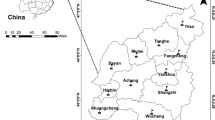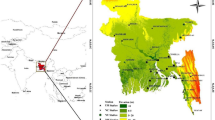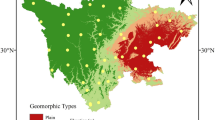Abstract
This study investigated the influence of evapotranspiration on future drought risk using bivariate drought frequency curves. Two different drought indices were used; SPI (Standardized Precipitation Index) which considers precipitation variation only and SPEI (Standardized Precipitation Evapotranspiration Index) which takes into account both precipitation and evapotranspiration variations. After generating the drought indices under the Representative Concentration Pathway (RCP) 8.5 scenario used in the Fifth Assessment Report (AR5) of IPCC, drought frequency analyses were performed and drought risks were estimated based on the joint quantiles of drought duration and severity. As a result, significant differences of drought risk were identified between SPI- and SPEIbased drought analyses using RCP 8.5 projections; mainly, the SPEI-based drought risk increases entirely across South Korea compared with the SPI-based drought risk. The outcomes of this study would be useful to develop comprehensive drought mitigation plans to cope with future climate change.
Similar content being viewed by others
References
Banimahd, S. A. and Khalili, D. (2013). “Factors influencing Markov chains predictability characteristics, utilizing SPI, RDI, EDI and SPEI drought indices in different climatic zones.” Water Resources Management, Vol. 27, No. 11, pp. 3911–3928, DOI: 10.1007/s11269-013-0387-z.
Bonaccorso, B., Cancelliere, A., and Rossi, G. (2003). “An analytical formulation of return period of drought severity.” Stochastic Environmental Research and Risk Assessment, Vol. 17, No. 3, pp. 157–174, DOI: 10.1007/s00477-003-0127-7.
Bonsal, B. R., Aider, R., Gachon, P., and Lapp, S. (2013). “An assessment of Canadian prairie drought: Past, present, and future.” Climate Dynamics, Vol. 41, No. 2, pp. 501–516, DOI: 10.1007/s00382-012-1422-0.
Camarero, J. J., Manzanedo, R. D., Sanchez-Salguero, R., and Navarro- Cerrillo, R. M. (2013). “Growth response to climate and drought change along an aridity gradient in the southernmost Pinus Nigra relict forests.” Annals of Forest Science, Vol. 70, No. 8, pp. 769–780, DOI: 10.1007/s13595-013-0321-9.
Chow, V. T., Maidment, D. R., and Mays, L. W. (1988). Applied hydrology, McGraw-Hill Book Company, New York.
Dorman, M., Svoray, T., Perevolotsky, A., and Sarris, D. (2013). “Forest performance during two consecutive drought periods: Diverging long-term trends and short-term responses along a climatic gradient.” Forest Ecology and Management, Vol. 310, No. 5, pp. 1–9, DOI: 10.1016/j.foreco.2013.08.009.
Edwards, D. C. and McKee, T. B. (1997). Characteristics of 20 th century drought in the United States at multiple time scales, Climatology Rep. 97-2, Department of Atmospheric Science, Colorado State University, Fort Collins, CO, 155.
Gonzalez, J. and Valdes, J. B. (2003). “Bivariate drought recurrence analysis using tree ring reconstructions.” Journal of Hydrologic Engineering, Vol. 8, No. 5, pp. 247–258, DOI: http://dx.doi.org/10.1061/(ASCE)1084-0699(2003)8:5(247).
Guttman, N. B. (1999). “Accepting the Standardized Precipitation Index: A calculation algorithm.” Journal of American Water Resources Association, Vol. 35, No. 2, pp. 311–322, DOI: 10.1111/j.1752-1688.1999.tb03592.x.
Im, S.-E., Ahn, J.-B., and Kim, D.-W. (2012). “An assessment of future dryness over Korea based on the ECHAM5-RegCM3 model chain under A1B emission scenario.” Asia-Pacific Journal of Atmospheric Sciences, Vol. 48, No. 4, pp. 325–337, DOI: 10.1007/s13143-012-0031-5.
IPCC (2007). Summary for policymakers. In Climate Change 2007: The Physical Science Basis. Working Group I Contribution to the Fourth Assessment Report of the Intergovernmental Panel on Climate Change (Solomon, S., Qin, D., Manning, M., Chen, Z., Marquis, M., Averyt, K.B., Tignor, M., Miller, H.L. (eds.)). Cambridge University Press, Cambridge, UK.
Kao, S. and Govindaraju, R. S. (2007). “A bivariate frequency analysis of extreme rainfall with implications for design.” Journal of Geophysical Research, Vol. 112, D13110. DOI: 10.1029/ 2007JD008522.
Kim, C. J., Park, M. J., and Lee, J. H. (2014). “Analysis of climate change impacts on the spatial and frequency patterns of drought using a potential drought hazard mapping approach.” International Journal of Climatology, Vol. 34, No. 1, pp. 61–80, DOI: 10.1002/joc.3666.
Kim, M.-K., Lee, D.-H., and Kim, J. (2013). “Production and validation of daily grid data with 1 km resolution in South Korea.” KU Climate Research Institute Publications, Vol. 8, No. 1, pp. 13–25.
Kim, T.-W., Valdes, J. B., and Yoo, C. (2003). “Nonparametric approach for estimating return periods of droughts in arid regions.” Journal of Hydrologic Engineering, Vol. 8, No. 5, pp. 237–246, DOI: 10.1061/(ASCE)1084-0699(2003)8:5(237).
Korea Meteorological Administration (KMA) (2008). Understanding of climate change and application of climate change scenario (I).
Lévesque, M., Saurer, M., Siegwolf, R., Eilmann, B., Brang, P., Bugmann, H., and Rigling, A. (2013). “Drought response of five conifer species under contrasting water availability suggests high vulnerability of Norway spruce and European larch.” Global Change Biology, Vol. 19, No. 10, pp. 3184–99, DOI: 10.1111/gcb.12268.
Mavromatis, T. (2007). “Drought index evaluation for assessing future wheat production in Greece.” International Journal of Climatology, Vol. 27, No. 7, pp. 911–924, DOI: 10.1002/joc.1444.
McKee, T. B., Doesken, N. J., and Kleist, J. (1993). “The relationship of drought frequency and duration to time scales.” In: Proceedings of the Eighth Conference on Applied Climatology, Am Meteorol Soc, Anaheim, CA, 179–184.
Ministry of Land, Transport and Maritime Affairs (1995). 1995 historical drought event survey report (in Korean).
Ministry of Land, Transport and Maritime Affairs (2002). 2001 historical drought event survey report (in Korean).
Mirakbari, M., Ganji, A., and Fallah, S. (2010). “Regional bivariate frequency analysis of meteorological droughts.” Journal of Hydrologic Engineering, Vol. 15, No. 12, pp. 985–1000, DOI: 10.1061/(ASCE)HE.1943-5584.0000271.
Mishra, A. K. and Singh, V. P. (2010). “A review of drought concepts.” Journal of Hydrology, Vol. 391, pp. 202–216, DOI:10.1016/j.jhydrol.2010.07.012.
National Institute of Meteorological Research (NIMR) (2011). A study on the support and use of climate change forecast technology (III).
Salas, J. D., Fu, C., Cancelliere, A., Dustin, D., Bode, D., Pineda, A., and Vincent, E. (2005). “Characterizing the severity and risk of drought in the Poudre River, Colorado.” Journal of Water Resources Planning and Management, Vol. 131, No. 5, pp. 383–393, DOI: http://dx.doi.org/10.1061/(ASCE)0733-9496(2005)131:5(383).
Senay, G. B., Velpuri, N. M., Bohms, S., Budde, M., Young, C., Rowland, J., and Verdin, J. P. (2015). Drought monitoring and assessment: Remote sensing and modeling approaches for the famine early warning systems network. In Hydro-Meteorological Hazards, Risks, and Disasters (Paron, P., and Baldassarre, G. (eds.)). Elsevier, Netherlands.
Shiau, J. T. (2003). “Return period of bivariate distributed hydrological events.” Stochastic Environmental Research and Risk Assessment, Vol. 17, Nos. 1-2, pp. 42–57, DOI: 10.1007/s00477-003-0125-9.
Shiau, J. T. (2006). “Fitting drought duration and severity with twodimensional copulas.” Water Resources Management, Vol. 20, No. 5, pp. 795–815, DOI: 10.1007/s11269-005-9008-9.
Sklar, A. (1959). “Fonctions de repartition a n dimensions et leurs marges.” Publ Inst Statist Univ Paris, Vol. 8, No. 1, pp. 11.
Song, X., Li, L., Fu, G., Li, J., Zhang, A., Liu, W., and Zhang, K. (2013). “Spatial–temporal variations of spring drought based on springcomposite index values for the Songnen Plain, Northeast China.” Theoretical and Applied Climatology, Vol. 116, Nos. 3-4, pp. 371–384, DOI: 10.1007/s00704-013-0957-2.
Thornthwaite, C. W. (1948). “An approach toward a rational classification of climate.” Geographical Review, Vol. 38, No. 1, pp. 55–94.
Van Vuuren, D. P., Edmonds, J., Kainuma, M., Riahi, K., Thomson, A., and Hibbard, K. (2011). “The representative concentration pathways: An overview.” Climate Change, Vol. 109, pp. 5–31, DOI: 10.1007/s10584-011-0148-z.
Vicente-Serrano, S. M., Beguería, S., and López-Moreno, J. I. (2010). “A multiscalar drought index sensitive to global warming: The standardized precipitation evapotranspiration index.” Journal of Climate, Vol. 23, No. 7, pp. 1696–1718, DOI: 10.1175/2009JCLI2909.1.
Wong, G., Lambert, M. F., Leonard, M., and Metcalfe, A. V. (2010). “Drought analysis using trivariate copulas conditional on climatic states.” Journal of Hydrologic Engineering, Vol. 15, No. 2, pp. 129–141, DOI: 10.1061/(ASCE)HE.1943-5584.0000169.
Xu, G., Liu, X., Qin, D., Chen, T., Sun, W., An, W., Wang, W., Wu, G., Zeng, X., and Ren, J. (2013). “Drought history inferred from tree ring d13C and d18O in the central tianshan mountains of china and linkage with the north atlantic oscillation.” Theoretical and Applied Climatology, Vol. 116, Nos. 3-4, pp. 385–401, DOI: 10.1007/s00704-013-0958-1.
Yevjevich, V. (1967). Objective approach to definitions and investigations of continental hydrologic droughts, Hydrology Paper 23, Colorado State U, Fort Collins.
Yoo, J., Kim, U., and Kim, T.-W. (2013). “Bivariate drought frequency curves and confidence intervals: a case study using monthly rainfall generation.” Stochastic Environmental Research and Risk Assessment, Vol. 27, No. 1, pp. 285–295, DOI: 10.1007/s00477-012-0588-7.
Yoo, J., Kwon, H.-H., Kim, T.-W., and Ahn, J.-H. (2012). “Drought frequency analysis using cluster analysis and bivariate probability distribution.” Journal of Hydrology, Vol. 420–421, pp. 102-111, DOI: 10.1016/j.jhydrol.2011.11.046.
Author information
Authors and Affiliations
Corresponding author
Rights and permissions
About this article
Cite this article
Yoo, J., Kwon, HH., Lee, JH. et al. Influence of evapotranspiration on future drought risk using bivariate drought frequency curves. KSCE J Civ Eng 20, 2059–2069 (2016). https://doi.org/10.1007/s12205-015-0078-9
Received:
Revised:
Accepted:
Published:
Issue Date:
DOI: https://doi.org/10.1007/s12205-015-0078-9




